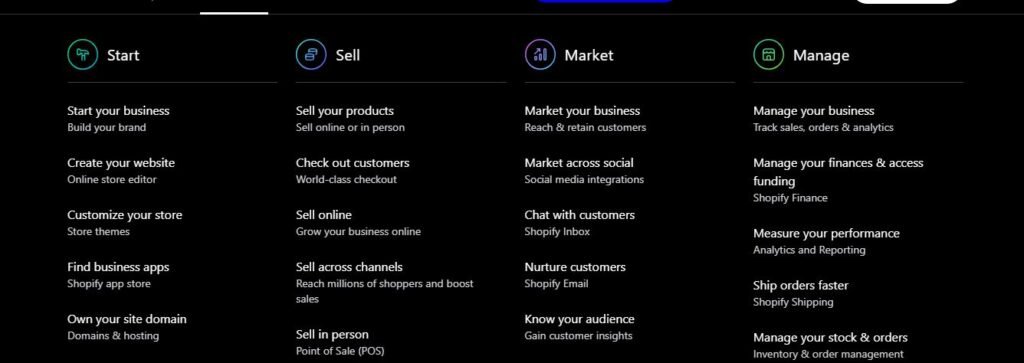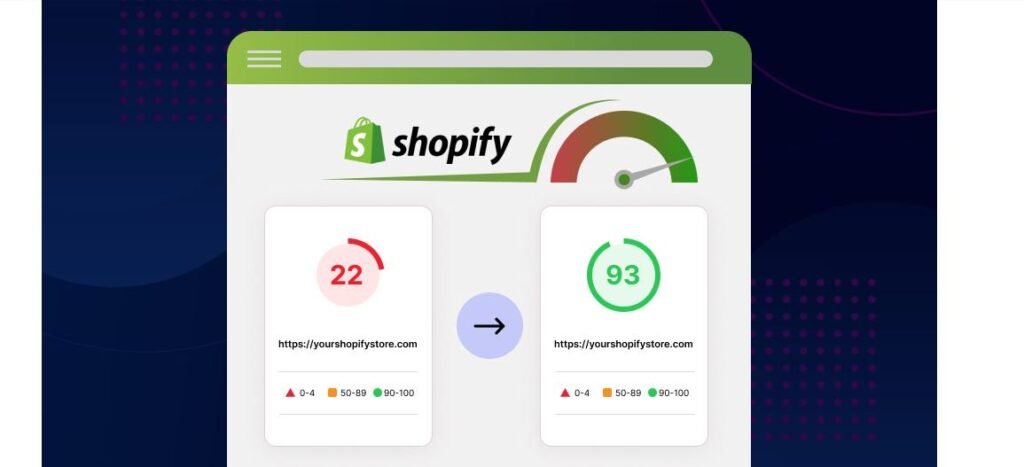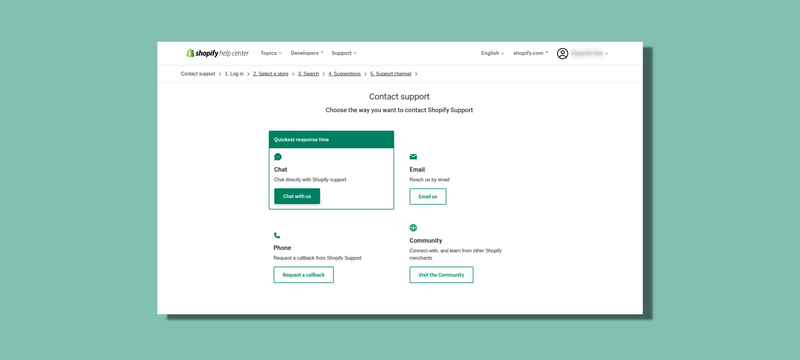Shopify Review |2025| Best dropshipping app
Ease of Use
Shopify is a leading e-commerce platform that enables businesses to create and manage their own online stores. Founded in 2006, it provides a user-friendly solution for entrepreneurs, small businesses, and large enterprises to sell products online. Shopify offers various tools for website customization, payment processing, inventory management, and order fulfillment, allowing users to focus on growing their businesses without needing advanced technical knowledge.
Get 40% off 3 Months or a Free Trial Shopify
Click Here
When evaluating an eCommerce platform, ease of use is one of the most important factors to consider. Shopify stands out as a user-friendly platform designed for entrepreneurs of all experience levels. Whether you’re launching your first online store or scaling an established business, Shopify offers a seamless experience that simplifies the process of building, managing, and growing your store.
Intuitive Dashboard
The Shopify dashboard is designed with simplicity in mind. Upon logging in, you’ll be presented with a clean, organized layout where you can manage all aspects of your online store—from products to orders and customer interactions. The easy-to-navigate interface ensures you spend less time figuring out how to use the platform and more time focusing on your business.
Quick Setup Process
Shopify makes it easy for beginners to get started. The setup process is guided, meaning you don’t need to worry about complicated installations or coding. Simply sign up, choose a theme, customize your store, and start adding products. For users who need extra help, Shopify offers step-by-step guides and tutorials throughout the setup process.
Where to add an image: A visual showing the “Setup Wizard” or the first steps of store creation.
Drag-and-Drop Functionality
Shopify also simplifies the store customization process with its drag-and-drop feature. You can easily modify your store’s layout by dragging elements like product grids, banners, and other components into place. This feature is especially useful for users who want a unique design without needing to know any code.
Where to add an image: A screenshot showing the drag-and-drop functionality in action.
App Integrations
For additional functionality, Shopify allows users to integrate third-party apps directly into their stores. Whether you need tools for email marketing, inventory management, or social media, the Shopify App Store offers thousands of apps that you can install with just a few clicks, making it easy to expand your store’s capabilities without technical skills.
Where to add an image: A screenshot of the Shopify App Store showcasing popular app options.
Mobile-Friendly Interface
In today’s mobile-first world, having a platform that works well on smartphones and tablets is crucial. Shopify offers a mobile-friendly interface, both for store owners and customers. You can manage your store and track orders from anywhere, while your customers can easily shop on any device, enhancing the overall user experience.
Where to add an image: A mobile screenshot of a Shopify store on a smartphone.
24/7 Customer Support
While Shopify’s platform is intuitive, there may still be times when you need assistance. Fortunately, Shopify provides 24/7 customer support through live chat, email, and phone. This ensures that even if you’re encountering an issue, help is always just a click away.
Where to add an image: A screenshot of the live chat support feature on Shopify’s website.
Overall, Shopify’s ease of use makes it an ideal choice for anyone looking to start or grow an online business. Whether you’re a complete beginner or a seasoned eCommerce pro, Shopify’s user-friendly interface ensures that you can focus on what matters most: running your business.
Pricing and Plans
When considering an eCommerce platform like Shopify, one of the most important factors to evaluate is the pricing structure. Shopify offers several pricing plans to cater to businesses of all sizes, from startups to established enterprises. Understanding the cost and features associated with each plan will help you choose the right one for your business needs.
Shopify Pricing Overview
Shopify offers three main pricing tiers: Basic, Shopify, and Advanced. Each plan provides access to the core eCommerce features but varies in terms of additional tools and scalability options. Pricing starts at $39 per month for the Basic plan and can go up to $399 per month for the Advanced plan. Shopify also offers a 14-day free trial, allowing you to test out the platform before committing to a subscription.
Where to add an image: A table or chart comparing the pricing tiers of the Basic, Shopify, and Advanced plans.
Basic Plan
The Basic Shopify plan is ideal for new businesses or entrepreneurs just getting started in eCommerce. At $39 per month, you get access to essential features such as an online store, unlimited products, and 24/7 customer support. However, some advanced features, like professional reports and advanced shipping options, are only available on higher plans.
Where to add an image: A visual highlighting the key features of the Basic plan, such as product listings and customer support.
Shopify Plan
The Shopify plan, priced at $105 per month, is a step up from the Basic plan and is best suited for growing businesses. This plan includes everything in the Basic plan, plus additional features like professional reports and more advanced shipping options. You also get better credit card transaction rates, which can be a significant cost-saving factor for businesses processing a higher volume of transactions.
Advanced Plan
The Advanced Shopify plan, priced at $399 per month, is designed for businesses that need advanced features and more scalability. This plan includes everything in the Shopify plan, plus advanced reporting and analytics, third-party calculated shipping rates, and the lowest transaction fees. It’s ideal for large-scale businesses that need more customization and support as they expand.
Shopify Plus
For high-volume merchants or large enterprises, Shopify offers a custom pricing plan called Shopify Plus. The pricing for Shopify Plus is tailored to the needs of the business, so you’ll need to contact Shopify directly for a quote. Shopify Plus provides additional customizations, priority support, and greater control over your online store’s functionality.
Where to add an image: A visual emphasizing the differences between Shopify Plus and other plans, such as scalability and custom features.
Additional Costs to Consider
In addition to the monthly subscription fees, there are a few other costs to keep in mind when using Shopify. These include transaction fees (if you’re not using Shopify Payments), the cost of third-party apps from the Shopify App Store, and any theme or custom development fees if you want a unique design for your store.

Conclusion
Shopify offers flexible pricing options that can accommodate a wide range of businesses, from small startups to large enterprises. The plans are well-structured to provide the features you need at each stage of growth. By carefully evaluating your business needs and budget, you can choose the plan that best suits your eCommerce goals.
Features and Customization
When it comes to running a successful online store, having the right features and customization options is key to providing a great customer experience and standing out from the competition. Shopify excels in both areas, offering a wide range of built-in features and customizable options that allow you to tailor your store to your specific needs.
Comprehensive E-commerce Features
Shopify provides all the essential eCommerce features to help you manage and grow your online store. These include inventory management, order tracking, and customer management tools. You can easily add, edit, and organize products, manage customer data, and keep track of your sales in real-time. With Shopify, you can also automate tasks like sending order confirmation emails and processing payments.
Where to add an image: A screenshot showcasing the Shopify admin panel with product management tools.
Store Design and Themes
Shopify offers a wide variety of professionally designed themes that are mobile-responsive and customizable. You can choose from free and paid themes based on your industry and style preferences. These themes are designed to provide a smooth user experience on all devices, which is crucial for retaining customers. Shopify allows you to customize themes using its built-in drag-and-drop editor or, for more advanced users, by directly editing the HTML/CSS.
Where to add an image: A visual showing different Shopify theme options or a screenshot of the theme customization screen.
App Integrations
Shopify’s extensive App Store is another standout feature. With thousands of apps available, you can enhance your store’s functionality with tools for email marketing, accounting, inventory management, shipping, and more. Many of these apps can be seamlessly integrated into your Shopify store, giving you access to advanced features without needing to code.
Where to add an image: A screenshot of the Shopify App Store showcasing popular apps for various store functions.
Customizable Checkout Process
Shopify allows you to customize the checkout process to ensure it meets your business’s specific needs. You can add custom fields, change the look and feel of the checkout pages, and choose from various payment options. This flexibility helps improve the user experience and can lead to higher conversion rates.
Where to add an image: A visual demonstrating the customization options available for the checkout page.
Advanced Reporting and Analytics
Shopify provides built-in analytics tools that give you valuable insights into your store’s performance. You can track sales, analyze customer behavior, and monitor marketing campaigns all within the platform. For more advanced reporting, higher-tier Shopify plans offer custom reports and in-depth data analysis, allowing you to make data-driven decisions to grow your business.
Where to add an image: A screenshot of Shopify’s analytics dashboard with graphs and sales data.
Third-Party Customizations
For businesses with more specific needs, Shopify’s API and developer tools provide opportunities for even greater customization. If you have coding knowledge or work with a developer, you can modify your store’s design and functionality beyond what’s available through the built-in tools. This level of flexibility makes Shopify suitable for both small businesses and large enterprises.
Where to add an image: A visual demonstrating API integrations or code customization options.
Multi-Channel Selling
Shopify allows you to sell on multiple platforms, including social media sites like Facebook, Instagram, and Pinterest. You can also integrate with marketplaces like Amazon and eBay. This multi-channel selling capability helps you expand your reach and drive more sales without needing to manage multiple separate platforms.

Design and Themes
When it comes to building an online store, the design is crucial for making a lasting impression on your visitors. A well-designed store can enhance the shopping experience, build trust with customers, and drive conversions. Shopify offers a wide selection of design options to help you create a professional and visually appealing store, regardless of your design expertise.
Wide Selection of Themes
Shopify provides a diverse range of themes to choose from, each tailored to different industries and business models. Whether you’re selling clothing, electronics, or digital products, you’ll find a theme that fits your brand’s style and objectives. Shopify offers both free and premium themes, giving you flexibility depending on your budget. All themes are mobile-responsive, ensuring your store looks great on any device, from desktop to smartphones.
Where to add an image: A screenshot of the Shopify theme store showcasing different theme options for various industries.
Customizable Design
Once you’ve selected a theme, Shopify makes it easy to customize the design of your store to align with your brand. The drag-and-drop editor allows you to make adjustments without needing to know any code. You can change fonts, colors, images, and layout elements, ensuring that your store matches your unique brand identity. For users with coding knowledge, Shopify also offers the ability to edit HTML, CSS, and Liquid (Shopify’s templating language), providing even more flexibility.
Where to add an image: A visual of the Shopify theme customization interface showing drag-and-drop features.
Free and Paid Themes
Shopify offers a variety of both free and paid themes. While the free themes are a great starting point for those on a budget, the premium themes come with additional features and enhanced design elements that may be worth the investment, especially for businesses looking for a more unique or advanced design. Paid themes typically come with additional support, more customization options, and more sophisticated design elements.
Where to add an image: A comparison of free vs. paid themes, showing examples of designs from both categories.
Theme Store Categories
Shopify’s theme store is categorized by industry, allowing you to find a theme that fits your business type. Categories include fashion, beauty, home goods, food and drink, electronics, and more. This organization makes it easy to browse themes that are tailored to your specific needs, ensuring you don’t waste time looking at irrelevant options.
Where to add an image: A screenshot showing the theme categories in the Shopify theme store, highlighting specific industries.
Mobile Optimization
In today’s digital landscape, having a mobile-friendly store is essential. Shopify’s themes are built with mobile optimization in mind, ensuring your store looks great and functions properly on smartphones and tablets. The mobile responsiveness of these themes allows customers to browse, add products to their cart, and complete purchases seamlessly, improving your store’s user experience and conversion rates.
Where to add an image: A visual showing how a Shopify store looks on a mobile device.
Speed and Performance
In addition to aesthetics, Shopify themes are designed to be fast and responsive. A well-designed theme will not only attract customers but also load quickly, which is crucial for providing a positive user experience and improving your site’s SEO. Shopify ensures that its themes are optimized for performance, so you won’t have to worry about slow loading times that could deter potential customers.
Where to add an image: A screenshot comparing load times between a Shopify store with a high-performance theme and one that is slower.
Advanced Customization with Liquid
For users who want even more control over their store’s design, Shopify offers Liquid, a flexible templating language that allows advanced customization of themes. Developers and technically inclined store owners can use Liquid to create complex features and personalized user experiences, such as custom product pages, dynamic content, and more.
Where to add an image: A code snippet showcasing Liquid customization in Shopify.
Theme Support and Updates
Shopify provides ongoing support for its themes, whether you’re using a free or paid option. All themes come with access to detailed documentation and customer support, so you can easily troubleshoot any issues you may encounter. Shopify also regularly updates its themes to ensure compatibility with new features and improvements.

Performance and Speed
When it comes to running an online store, performance and speed are critical factors that directly impact user experience, SEO, and ultimately, conversions. Shopify is designed to deliver fast loading times and reliable performance, ensuring that your customers enjoy a smooth browsing and shopping experience. Let’s take a closer look at how Shopify ensures high performance and speed for your eCommerce store.
Fast Loading Times
Shopify places a strong emphasis on speed, as slow-loading websites can lead to higher bounce rates and lost sales. Shopify themes are optimized for fast performance, ensuring that your store loads quickly, even with high-resolution images and complex product pages. Faster load times can improve user satisfaction and increase the likelihood that customers will complete their purchases.
Where to add an image: A comparison of loading times between a Shopify store and a slow-loading competitor’s website.
Optimized for Mobile
With the growing number of shoppers using mobile devices, Shopify ensures that your store is optimized for mobile performance. Mobile responsiveness is built into every Shopify theme, ensuring that your store’s pages load quickly on smartphones and tablets. This is crucial not only for providing a great user experience but also for boosting your SEO ranking, as search engines prioritize mobile-friendly websites.
Where to add an image: A visual showing a Shopify store’s mobile optimization, highlighting fast load times on a mobile device.
Global Hosting Network
Shopify uses a global content delivery network (CDN) to host its stores. This means that your store’s assets (images, scripts, stylesheets) are served from a network of servers located in different parts of the world. When a customer visits your store, the content is delivered from the server closest to them, reducing latency and ensuring faster load times regardless of the customer’s location.
Where to add an image: A visual illustrating how Shopify’s global CDN works, showing servers across the world and how content is delivered quickly.
Automatic Image Optimization
Shopify automatically optimizes images to reduce their file size without compromising quality. Large image files can slow down your site, so Shopify’s image optimization tools ensure that your product images load quickly, improving site performance. This feature is particularly useful for eCommerce stores that rely on high-quality product images to attract customers.
Where to add an image: A before-and-after visual showing the impact of Shopify’s image optimization on file size and image quality.
Shopify’s Infrastructure
Shopify’s infrastructure is built to handle high volumes of traffic without compromising speed. Whether you’re a small business or an enterprise-level store, Shopify’s platform is scalable and designed to handle growth. Shopify’s cloud-based infrastructure ensures that your store can perform reliably during traffic spikes, such as sales events or product launches.
Where to add an image: A visual showing the scalability of Shopify’s cloud infrastructure, highlighting its ability to handle traffic spikes.
App Performance
While Shopify offers a wide range of third-party apps to extend your store’s functionality, it also ensures that these apps do not negatively impact your site’s performance. Shopify’s App Store features apps that are optimized for speed and compatibility, and the platform regularly checks to ensure that apps do not slow down your store. This helps maintain high performance, even as you add more features to your store.
Where to add an image: A screenshot of the Shopify App Store with emphasis on speed-optimized apps.
SEO and Performance Impact
Search engines like Google factor page speed into their rankings, meaning that a faster Shopify store can have a positive impact on your SEO efforts. Shopify’s performance features, such as fast load times and mobile optimization, help your store rank higher in search engine results, attracting more organic traffic and improving your store’s visibility.
Where to add an image: A diagram showing the relationship between page speed and SEO rankings.
Regular Performance Updates
Shopify continuously updates its platform to improve performance and speed. These updates include improvements to server infrastructure, app compatibility, and other technical enhancements to ensure that Shopify stores run at optimal speed. As a result, store owners don’t need to worry about performance issues as their business grows.

Security
Security is one of the most critical aspects of running an online store, especially when handling sensitive customer data and financial transactions. Shopify places a high priority on security, ensuring that both store owners and customers can shop and manage their businesses with peace of mind. Here’s an overview of how Shopify keeps your store and data secure.
SSL Encryption for Safe Transactions
One of the most important security features Shopify offers is SSL (Secure Sockets Layer) encryption. SSL ensures that all data transmitted between your customers and your store, such as payment information and personal details, is securely encrypted. When a store is protected with SSL, customers will see a padlock symbol next to your website’s URL, which helps build trust and ensures that sensitive information is protected from hackers.
Where to add an image: A visual showing the padlock symbol next to a Shopify store’s URL to indicate SSL protection.
PCI Compliance
Shopify is PCI DSS (Payment Card Industry Data Security Standard) compliant, which means it meets the strict security standards set for handling credit card transactions. This compliance ensures that Shopify’s infrastructure protects your customers’ payment information and prevents unauthorized access. Shopify handles all the security requirements for processing payments, so you don’t need to worry about managing sensitive data yourself.
Where to add an image: A diagram explaining PCI compliance and how Shopify adheres to these standards.
Two-Factor Authentication (2FA)
Shopify offers two-factor authentication (2FA) for store owners and staff members. This feature adds an extra layer of protection by requiring a second form of verification, such as a code sent to your phone, in addition to your password. Enabling 2FA helps protect your Shopify store from unauthorized access, even if someone gains access to your login credentials.
Where to add an image: A screenshot of the Shopify 2FA setup process.
Fraud Prevention Tools
Shopify includes built-in fraud prevention tools that help you identify and block potentially fraudulent transactions. These tools monitor various risk factors, such as high-ticket orders or mismatched billing and shipping information, and provide alerts when suspicious activity is detected. By using these tools, you can reduce the risk of chargebacks and financial losses from fraud.
Where to add an image: A screenshot showing Shopify’s fraud prevention dashboard with alerts and risk factors.
Data Security and Backup
Shopify employs a robust system for data security and backup. Your store data is regularly backed up and stored securely, so in the event of a technical issue, you can restore your store’s information quickly. Shopify also uses strong encryption protocols to protect stored data, ensuring that it is kept safe from unauthorized access.
Where to add an image: A visual illustrating Shopify’s data backup and security protocols.
Regular Security Updates
To maintain a high level of security, Shopify regularly updates its platform with the latest security patches and enhancements. These updates address potential vulnerabilities and ensure that your store stays protected from emerging threats. By handling these updates automatically, Shopify makes it easy for you to keep your store secure without having to manage them yourself.
Where to add an image: A visual showcasing Shopify’s automatic security updates to ensure protection.
DDoS Protection
Shopify has built-in DDoS (Distributed Denial of Service) protection to defend against attacks that try to overload your store with traffic and make it unavailable. Shopify’s advanced infrastructure automatically detects and mitigates DDoS attacks, ensuring that your store remains online and accessible to customers even during these malicious attempts.
Where to add an image: A graphic showing how Shopify’s DDoS protection works to prevent service interruptions.
Shopify Payments Security
Shopify Payments is Shopify’s integrated payment solution, and it offers an added layer of security for transactions. By using Shopify Payments, you can avoid the need to work with third-party payment processors, reducing the risk of data breaches. Shopify Payments is fully integrated with the platform’s security features, offering seamless protection for every transaction.

Customer Support
Exceptional customer support is a crucial factor for the success of any online store. Whether you’re troubleshooting an issue or seeking guidance on optimizing your store, having access to responsive and knowledgeable support can make all the difference. Shopify excels in this area, offering comprehensive customer support to help store owners manage their eCommerce businesses with confidence. Here’s a closer look at the customer support options Shopify provides.
24/7 Support
One of the standout features of Shopify is its 24/7 customer support. No matter when an issue arises—whether it’s late at night or during a holiday—Shopify’s team is available to assist. You can reach customer support via multiple channels, including live chat, email, and phone, ensuring that help is always accessible when you need it the most.
Where to add an image: A visual showing the various customer support channels, such as live chat, phone support, and email.
Comprehensive Help Center
Shopify’s Help Center is a valuable resource for store owners, providing access to a vast library of articles, tutorials, and guides. These resources cover a wide range of topics, from store setup and theme customization to marketing strategies and troubleshooting. The Help Center allows you to find answers to your questions quickly, without having to contact support.
Where to add an image: A screenshot of the Shopify Help Center homepage, highlighting key sections like “Getting Started” and “Troubleshooting.”
Shopify Community
For peer-to-peer support, Shopify offers an active online community where store owners can connect, ask questions, and share advice. The Shopify Community is a great place to find solutions to common issues, exchange tips with other entrepreneurs, and learn from others’ experiences. It’s an excellent supplement to Shopify’s official support channels.
Where to add an image: A screenshot of the Shopify Community forum, showing active threads and discussions.
Shopify Academy
Shopify Academy provides free online courses and tutorials designed to help you become a better store owner. These courses cover a variety of topics, such as improving sales, using Shopify tools, and understanding eCommerce best practices. By taking advantage of Shopify Academy, you can gain in-depth knowledge and skills that will help you optimize your store and grow your business.
Where to add an image: A visual showcasing Shopify Academy’s course offerings, with sections like “Sales & Marketing” and “Store Setup.”
Dedicated Account Support (Shopify Plus)
For high-volume merchants, Shopify offers a higher level of support through Shopify Plus. Shopify Plus customers receive dedicated account support, including a team of experts who provide personalized guidance and assistance. This level of support is ideal for businesses that require more complex solutions or have specific needs related to customization, integrations, or scaling.
Where to add an image: A visual showing the benefits of Shopify Plus support, such as a dedicated account manager and personalized solutions.
Multi-Language Support
Shopify offers multi-language support, ensuring that store owners from different parts of the world can receive assistance in their preferred language. This is particularly helpful for international merchants who may have language barriers when seeking help. Shopify’s global support teams are equipped to provide high-quality support in a variety of languages, making the platform accessible to a wide range of users.
Where to add an image: A graphic highlighting Shopify’s multi-language support, showing flags of different countries or languages offered.
Response Time and Efficiency
Shopify is known for its quick response times and efficient customer service. Whether you’re reaching out through live chat or phone support, the Shopify team is trained to address your concerns as quickly as possible. This fast response time minimizes downtime and ensures that issues are resolved without prolonged delays.
Where to add an image: A visual comparison of Shopify’s quick response time versus longer response times with other platforms.
Shopify Compass
In addition to live support, Shopify Compass is a tool that offers valuable insights and resources to help you run and grow your business. It features tutorials, webinars, and articles that cover everything from setting up your store to mastering advanced marketing strategies. With Shopify Compass, you’ll have a wealth of knowledge at your fingertips, helping you navigate every stage of your eCommerce journey.

Intro (Paragraph)


